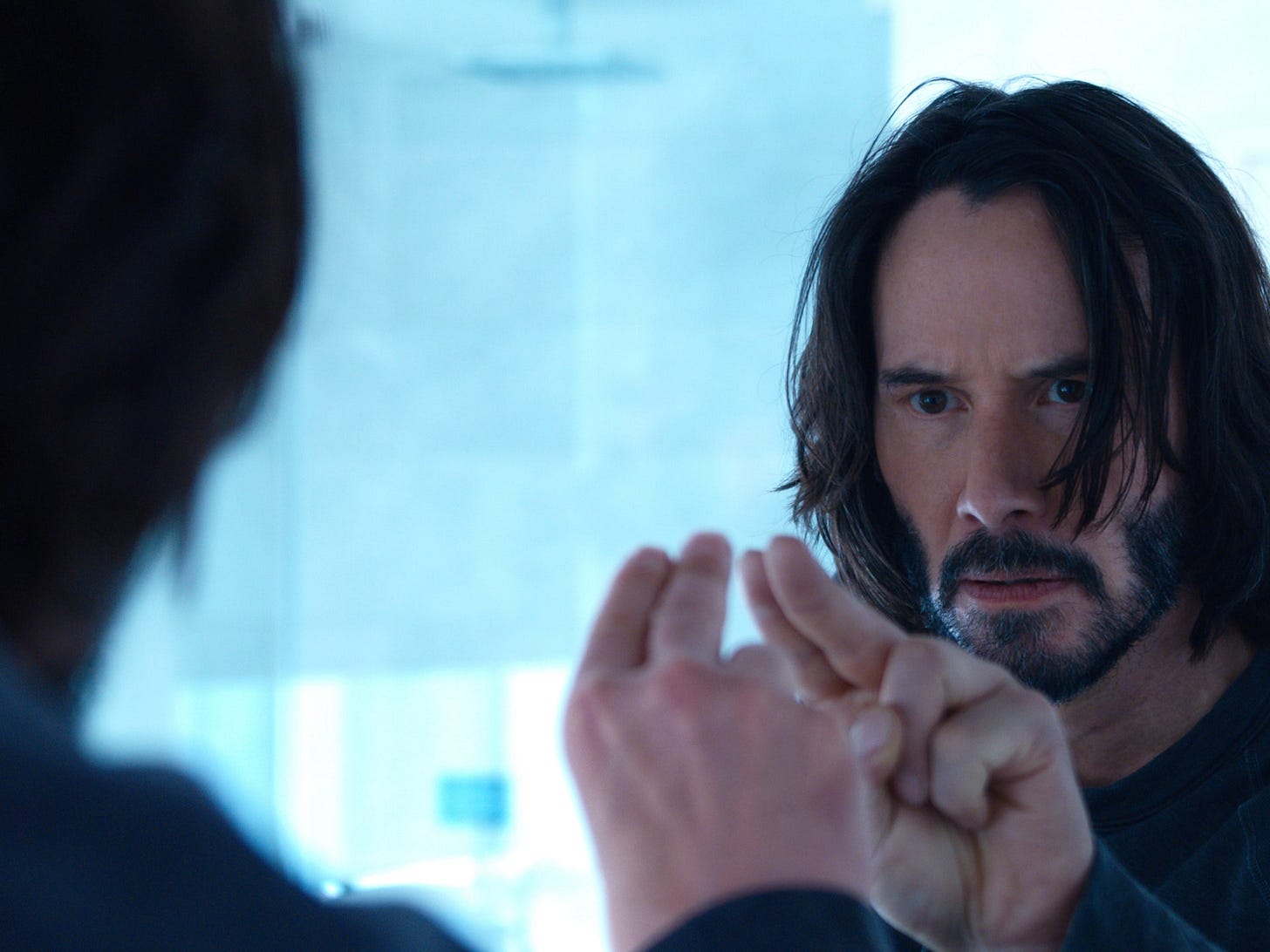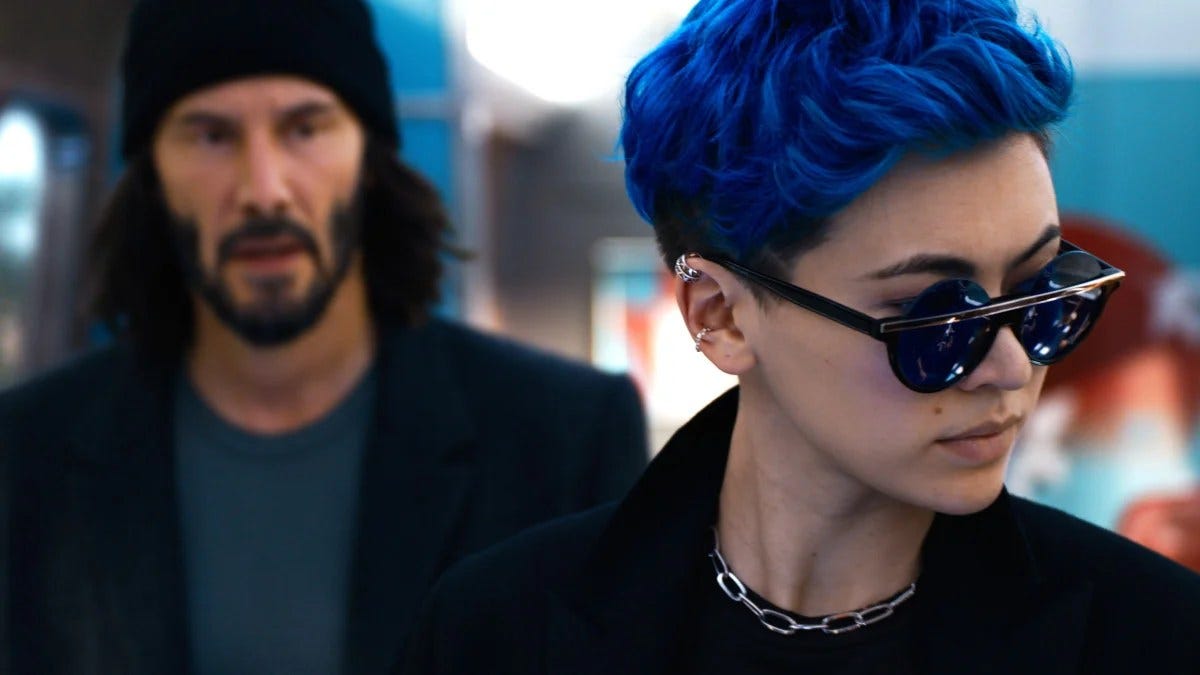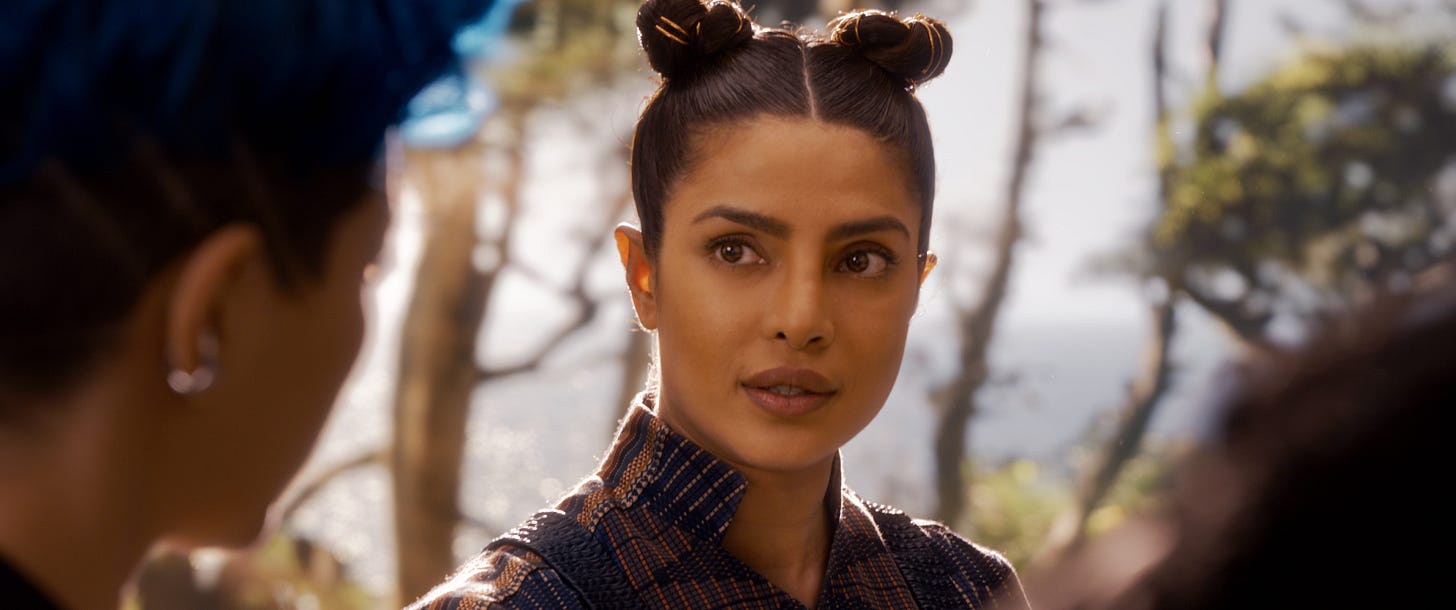I don’t really know if this is true. But I imagine that, for years, Warner Bros. has been frequently taking meetings with the Wachowskis about making another “Matrix”. The much-derided “The Matrix Revolutions” still grossed $427 million worldwide in 2003 dollars, so why wouldn’t they suggest the Wachowskis try again? It seems as if, during the course of these meetings, the siblings would be able to convince the WB, or another production company, to pony up for unrelated, seemingly absurd flights of fancy, each one more peculiar and uncommercial than the last.
In prison I got to see “Jupiter Ascending”, one of these particularly wild experiments. This was supposedly their “commercial” movie, meant to be a trilogy starter where earthbound queen Mila Kunis was to rule the spaceways with her half-wolf bounty hunter lover Channing Tatum and his charming laser rollerblades. Divorced from all the bad buzz, I had a hard time seeing how that amusingly daft trifle was meant to withstand three whole movies. Maybe the Wachowskis were done.
Well, maybe the Wachowskis as a duo were done. Something must have clicked for Lana Wachowski so she opted to go solo for “The Matrix Resurrections”. And I imagine that part of what fueled her creativity was channeling all of those probably-dopey meetings with simpleton executives who had no real ideas beyond another bite of the “Matrix” apple into a concept and a script that Warner Bros. would simply okay sight unseen, assuming that any “Matrix” is enough “Matrix” until the next “Matrix”. It really seems like some movie executives are just junkies in an alley, desperate for a syringe filled with IP.
“Resurrections” begins as a nostalgia act right away, a bizarre choice considering “The Matrix” is one of the most rewatched movies of the last (oh man!) twenty six years. We’re placed into the first scene of the original film, where a then-unknown catsuit-wearing burglar is using gravity-and-time-defying martial arts to defeat a group of zombie cop villains piloted by pixel interference. But this time, we’re watching over someone’s shoulder, in this case Bugs (Jessica Henwick).
Ok, act break: hey, guys, I gotta be real with you. I watched this twice, and I don’t know where Bugs is coming from, or how she’s watching this. I heard a couple of written explanations that contradicted each other. I’m not certain. The point is that she starts to narrate the sequence like it’s a DVD commentary, spotting what’s interesting, noting what’s different from the last time. It’s a “Matrix” loop, and she’s watching it the way a coder would observe code, finding that she can remove and isolate elements (in this case a body that served as a home for Morpheus). Naturally, the bad guys (followers of Agent Smith) try to prevent this, and we get a bunch of fighting and jumping and all that Matrix-y stuff. Henwick basically gets to redpill Yahya Abdul-Mateen II (as in, free him from the Matrix, not make him listen to moronic manosphere podcasts), and it’s revealed that these two are essentially superfans of the original movie, er, simulation. This one’s for the nerds, y’all!
And then, a thematically violent course correction. We’re back with Neo, and he’s… just chilling. I think a lot of us wondered, at the apocalyptic end of “The Matrix Revolutions”, what now? Doubtful that we’d suggest that Neo is now Thomas Anderson again, no longer a cubicle drone, but in fact a wealthy and successful videogame developer. But so he is. He’s become a massive success off “The Matrix”, a game he designed off distant visions and imagery in his head that we know are clips from “The Matrix”. This movie is nearly two and a half hours long, and frankly, a lot of it is recycled footage from “The Matrix”.
Anderson’s new mission is to design a sequel to his hit game, but it involves us sitting in with him in meetings where he has to listen to braindead executives with their asinine story suggestions that are simply weak justifications for continuing the saga. It’s not enough that we’re satirizing the corporate groupthink over at Warner Bros. – there has to be a reveal that the villains hoping to kill Anderson are in fact his coworkers and bosses, led by a reincarnated Agent Smith (Jonathan Groff). I didn’t intend for it to be this way, but I’ve reviewed two Warner Bros. movies this week that reveal their villains are basically the executives at the studios who have spent years pathetically begging for new installments to beloved originals. I doubt they’re aware of this – after all, they’re in development on yet another new “Matrix” movie without the Wachowskis. Are executives at these studios really that dim? I believe they are. The modern age has increased knowledge and accessibility for some, and as a result the general public has more and more information on how people in power at historically-significant institutions are considerably unaware of what they’re doing or how it can be maximized. These execs look at a studio’s history and say, how can we just keep making more of these? And people like Lana Wachowski openly mock them for it.
I wish I could say this is a point for Lana here, but whoo boy this is dizzying. Once Anderson is plucked out of the Matrix again, he has to go through a remixed version of the same trials he sampled in the first film. A lot of it is almost exactly the same, which is Wachowski making a point, but one made for an extended runtime, slowly and obviously. It reads as a middle finger as such – this is a deeper, more philosophical analysis of what it means to realize your true self away from the crushing monotony of everyday life/simulation. Perhaps Lana is trying to reclaim the idea of the red pill from weak-kneed misogynists with mommy issues that currently dominate so many online and real-life spheres.
From then on, Neo is back with the rebellion, a new crew (sadly, one we don’t get to know, but they look fabulous!) that busts him back into the Matrix to save Trinity. Along the way, they need to battle Neo’s true adversary, his analyst (Neil Patrick Harris), who has been quietly prescribing blue pills to him this entire time. Wow, that’s the angle they came up with for a new “Matrix”. I still can’t really believe it. There are a few more action scenes where everyone gets to be a part of the action. I’m unclear as to why Keanu Reeves and Carrie Anne-Moss returned – supposedly their characters survived while others simply died. But then there’s a weird moment when the slick-talking Merovingian from part two (Lambert Wilson) reemerges as a brainrot hobo preacher bellowing existential complaints about modern life during a massive fight scene.
What I gathered from all the monologuing (in part from co-writer David Mitchell, the novelist the Wachowskis adapted for “Cloud Atlas”) was that the machines were no longer controlling humans via mind control, but through suggestion and emotional interplay. So, the internet, basically, and/or narcissism and targeted misinformation, etc. Flattery. Y’all know what that means – technology is going to play a massive part (and Keanu gets to snuggle with a robot drone at one point), but the meaning of all this is true love. Movie science dictates that real science is powerless against love, so this shouldn’t be a surprise. Believe Movie Science, guys.
Though this movie is suffused with the sort of side quests that nerds adore, the main goal seems to involve Neo and company seizing the Matrix back, much how Lana Wachowski has done. “The Matrix” has been used ad nauseum as a metaphor from some of the worst people taking advantage of the perceived malleability of the idea. Maybe this pissed off one Wachowski and not the other. I’ve thought about this a lot, the idea that artists across the industry are starting to realize the last couple of decades of metaphors, satires and veiled references have not done enough to sway the world away from the edge. “The Matrix” didn’t work, Wachowski is saying, but maybe this approach will do the job. And she’s also saying, maybe you don’t deserve this, you idiots. It’s hard for me to disagree.
Obviously, Lana Wachowski went through quite a journey from that first “The Matrix”, from “Bound” (the first Wachowski film), to now. During that time, she and her sibling transitioned, while their approach has changed, deepened, grown more curious, less self-conscious about their identities. Much of their concern regarding “The Matrix” likely stems from how it seemed co-opted by “fans” who would consider transgender people illegitimate, unacceptable, some sort of abomination in front of a god that, weirdly, was also in league with the beliefs of those manipulating a global system of unchecked capitalism. Weird God. People spent a quarter of a century loving the Wachowskis’ creation, but hating them. Or worse, considering the Wachowskis are some sort of exception to this everyday phobic hate because the siblings had produced a product of value (one that may have, paradoxically, allowed them to feel more comfortable in their own hateful, ignorant skin).
I tried to speak to inmates in prison about this. Black, Hispanic, white, I tried to emphasize to all of them, whatever they felt, they were now, as prisoners, marginalized people. Obviously this was easier for Blacks and Hispanics to understand, as many of them came from low-income environments without strong career prospects, they were used to added scrutiny from law enforcement. It didn’t catch on with as many white inmates. Some of them earnestly expected to just walk out of prison and immediately continue the life they always led, glide through the same opportunities they had before. And a lot of these white men were sex offenders. I’m not certain what the origin was for such irrational exuberance.
But I wanted to emphasize to all of them that the institution(s) want them to behave in a certain way. They were marginalized, they were under a thumb – some of them go on to feel as if they’re under that thumb forever, and it hinders them psychologically more than it does practically. The same opportunities aren’t available, and so they would be considered malignant elements of society. The world would always be against them unless they rose to an unlikely and fluke-ish level of success. But it was important to let them know that they weren’t isolated. There are many marginalized people in society.
These men were homophobes, they hated and derided transgender people, anything that didn’t resemble a dull, sheltered and scared idea of traditional masculinity. Even when we ended up with a few transgender inmates, the hate was loud and outspoken (though after dark, there was a surprising level of contradiction, but that’s a story for another time). I tried speaking to them about this, but I was only one voice. However they felt about transgender people, LGBTQ+ citizens were under attack, then and especially now, and they were marginalized much like we were. To suffer under the thumb of institutional repression is to have a great deal in common with the transgender community. After prison, one must swallow whatever discomfort they may have and pull up and protect other marginalized people, because in one fell swoop, we could all be in danger. I would say we need more programming to emphasize how marginalized people must open their minds and help other marginalized people because they are stronger together, and I would believe that. Unfortunately, this is yet another idea that would force the Bureau Of Prisons to admit they are the villain, or beside the villain. You can’t remind an oppressor they’re an oppressor unless you wish to feel their idiot wrath.











I raise my hand as not only being a defender of “Reloaded” and “Revolutions”, but also being one of the people who absolutely LOVES “Resurrections”. (I saw it twice in theatres, and for me to see to see any movie more than once on the big screen is a huge rarity.)
To quote my single sentence Letterboxd review of the film at the time, I love it because I see it as “the ‘Twin Peaks: The Return’ of ‘Matrix’ sequels”.
Plus, it helps to bear in mind that Lana Wachowski decided she wanted to make the film after all as a means of processing her grief over the loss of her parents, and as much as it was a boon to Warner Brothers having gagged for a new “Matrix” for years, the act of bringing back Neo and Trinity was Wachowski finding comfort and catharsis in resurrecting characters she loved, and whom she could bring back to life. The film may outwardly mock Warner Bros and the IP-regurgitating machine to their faces, but “Resurrections” is borne of genuine heart and soul, with zero ironic detachment. Yeah, the action sequences aren’t as masterfully executed as in the OG trilogy, and the motion blur-heavy digital cinematography isn’t ideal, but I believe the positives far outweigh any of the negatives.
=))
I never bought the Wachowskis' remark about The Matrix being a trans allegory this whole time. It works, but only very gratuitously. I didn't care for how they spoke about their Cloud Atlas adaptation either, but I'd be willing to revisit that one.
That's neither here nor there, though. I find it equal parts nauseating and illuminating how quickly prejudice is buried when the otherwise-target of said prejudice proves to be an asset to the market. This hatred is far more strategic than it is emotional, and even when it is emotional, there's an overwhelming element of strategy in cancerously divulging and evoking those emotions. It's all so clearly a product of people not knowing what they believe in, which I would argue both applies to and is leveraged by the Warner Bros. execs you mention here.